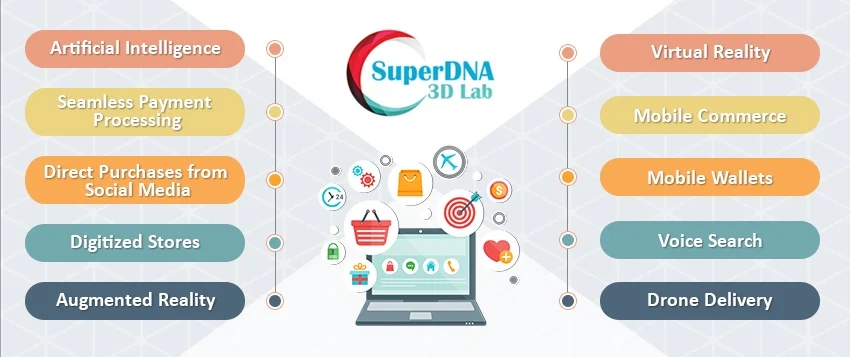
In recent times, technology has become a cornerstone of growth for almost every industry and e-Commerce is no exception. New developments in technology are impacting the e-Commerce world by revolutionizing the process, by which consumers can seamlessly connect with brands and shop online without any hassle. With the rapid evolution of the e-commerce industry, businesses must adapt to the ongoing trends going around the online shopping world to stay on top of the competition and remain profitable.
E-Commerce giants like Amazon, Walmart, and Alibaba are revamping themselves through technological innovations and advancements. To survive in today’s competitive market, retailers must adopt new technologies that enable them to simplify business processes and provide satisfaction to their customers.
Here are the technologies that are revolutionizing the e-commerce industry:
1) Artificial Intelligence
• Smart Chatbots
E-Commerce websites are making use of chatbots to enhance customer support and service. As buyers are more impatient than ever, expecting lightning-fast responses to their inquiries round the clock, e-commerce businesses face difficulties to meet these requirements in real-time. This is where the requirement of automated chatbots arises – the chatbots that are smarter and able to store data and analyze it. One can specify their requirements to the chatbot and will be served with the processed results. Chatbots are created using artificial intelligence to serve the purpose of communicating with humans by understanding their queries. For example, the Facebook Messenger chatbot can locate products and guide customers to make purchases through conversations.
• Image Search Recognition
Many times, we come across a situation where we look for a product whose image lies in our smartphone however, we don’t know what it is called. Artificial intelligence services can help us here. By using the application of artificial intelligence, the concept of image search is carried out on e-commerce websites. AI understands the images and displays the relevant results. Users can make searches based on images. Mobile apps of e-commerce websites can find a product just by scanning the actual product with a camera. This eliminates the need for keyword searches.
2) Seamless Payment Processing
Smooth customer experience is a huge driving force for e-Commerce companies which encourages faster shopping transactions. When online payment issues arise, which is one of the main causes of cart abandonment, the business incurs a significant loss. To overcome this, online retailers are adapting to technologies that enable faster and smarter payments. The past few years have seen a shift from traditional payment methods to modern and sophisticated ones like PayPal, Paytm, and digital currencies like Bit coin, etc.
3) Direct Purchases from Social Media
Various social media channels like Facebook, Pinterest, and Instagram are currently used as marketing channels where e-Commerce websites showcase their products based on users’ history. When a user clicks on the ‘Buy now button, it directly takes the user to the e-Commerce site and provides the option to make an online payment and buy the product.
4) Digitized Stores
Despite the growing e-commerce stores, brick-and-mortar stores always dominate and will never go to lose their value anytime soon. However, to cater to the online customers, they have started adopting digitization and taking their business online along with running the existing physical store. Companies like eBay, Walmart, and Sephora have started digitizing very early. They are using memory mirror technology, which involves a virtual mirror where a person can look at herself and visualize how they look in a particular outfit. They don’t need to wear it. Users can explore various options like size and color, and identify what meets their requirements the best.
5) Augmented Reality
AR has the potential to do wonders for an online business. AR is capable of providing users with an in-store shopping experience on their mobile. With the growing interest of customers in AR technology, e-Commerce is realizing the potential and benefits of adopting this technology. AR combines the physical world with digitally generated graphics which are superimposed on the view to give an idea that how an object will look in a real-life application. AR certainly can blur the boundaries between online and offline shopping – by providing buyers with everything they need at their fingertips.
For example, AR allows consumers to virtually try furniture in their home environment which helps in lowering the returns on products that do not fit one’s requirements. One of the first SDK platforms is Apple’s ARKit, leveraged by IKEA which allowed their consumers to virtually try furniture in their homes and visualize what product will look like through mobile apps.
Another example is Gap’s dressing room app that brings AR magic to apparel by allowing users to see how garments look on a mannequin of their selected size. According to Statista, AR growth in devices and revenue is expected to be worth $54 billion by 2020, which gives retailers, even more, push to experiment with the tool.
6) Virtual Reality
Virtual reality is a computer-simulated reality that combines technology and design to create an immersive environment that gives users a feel like they truly entered a different environment altogether. With the endless potential of storytelling, it is quickly evolving within the e-Commerce industries. To fascinate online users and provide them with a whole different online shopping experience, retailers are working on creating virtual showrooms – that resemble physical store experiences.
One of the notable applications of VR technology is Lowe’s Holoroom, a tool, which is leading the way in virtual showrooms. Lowe’s Innovation Labs conveys that by making use of virtual showrooms, customers can visualize their ideal result and it allows them to become aware of how multiple products would work when put together.
This provides consumers with a more realistic shopping experience. Users can put on a headset at home and they will find themselves in a virtual superstore where they can shop for virtual products in the same way they do in a physical store.
To know more about how the latest technologies can help you in growing your business. Click here.